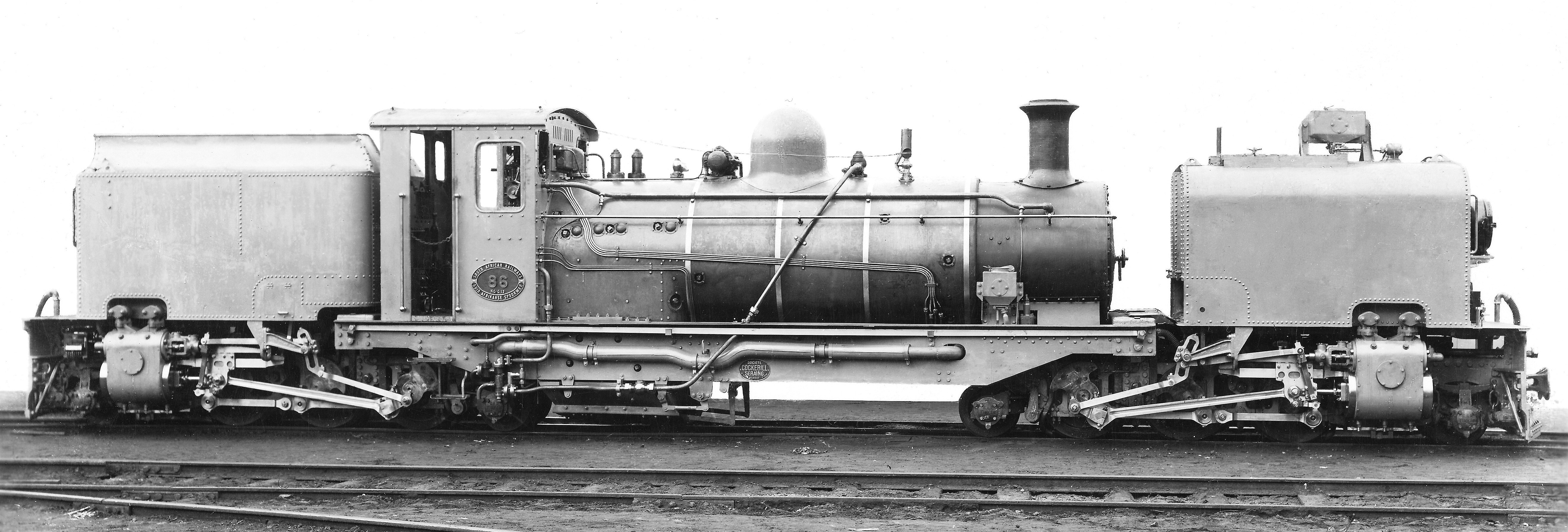|
SAR NGG 16 Class
The South African Railways Class NG G16 2-6-2+2-6-2 was a narrow gauge steam locomotive. Between 1937 and 1968, the South African Railways placed 34 Class NG G16 Garratt articulated steam locomotives in service on the Avontuur Railway and on the Natal narrow gauge lines. Manufacturers The success of the Class NG G13 narrow gauge Garratts that were introduced by the South African Railways (SAR) in 1927 led to a decision that any additional narrow gauge articulated locomotives would be of the same design. Altogether 34 more Double Prairie type narrow gauge locomotives were built, spread over five orders from three manufacturers over a span of 32 years.South African Railways and Harbours Locomotive Diagram Book, 2'0" & 3'6" Gauge Steam Locomotives, 15 August 1941, as amended Cockerill In 1937, Société Anonyme John Cockerill of Seraing in Belgium delivered four new locomotives, numbered in the range from NG85 to NG88, which were so similar to the older locomotives ... [...More Info...] [...Related Items...] OR: [Wikipedia] [Google] [Baidu] |
Sandstone Estates
Sandstone Estates (Pty) Ltd is a large commercial agricultural enterprise covering over , located on the border with Lesotho in South Africa's Eastern Free State province, close to the Maluti Mountains. The nearest town is Ficksburg, away on the R26. It is a hub of transport preservation. History The farm was built up by the Wille family from the 1830s, who were originally German missionaries. Today it is part of an international agri-business that produces wheat, soya beans, maize and sunflowers. It has been 100% organic since 2005. As steam enthusiasts, in the mid-1990s, the Sandstone owners were approached by Alan Clarke of Transnet Heritage Foundation, who realised the foundation did not have the resources to rescue the collapsing Midmar Museum in KwaZulu-Natal. The collection formed the basis of what became the Sandstone Heritage collection. Today, the main collection is still based around the railway transport of Southern Africa, but also covers an extensive global roa ... [...More Info...] [...Related Items...] OR: [Wikipedia] [Google] [Baidu] |
South African Class NG G13 2-6-2+2-6-2
The South African Railways Class NG G13 2-6-2+2-6-2 of 1927 was a narrow gauge articulated steam locomotive. Between 1927 and 1929, the South African Railways placed twelve Class NG G13 Garratt articulated steam locomotives with a 2-6-2+2-6-2 Double Prairie type wheel arrangement in service on the Langkloof and Alfred County Railway narrow gauge lines.Espitalier, T.J.; Day, W.A.J. (1946). ''The Locomotive in South Africa - A Brief History of Railway Development. Chapter VII - South African Railways (Continued).'' South African Railways and Harbours Magazine, February 1946. p. 135. Manufacturer In 1927, Hannoversche Maschinenbau (Hanomag), in consultation with the South African Railways (SAR), designed a locomotive which was to become the standard narrow gauge Garratt locomotive in South Africa for the next forty years. How Garratts, to which Beyer, Peacock & Company held the patent, came to be designed and built by the German firm of Hanomag was the result of the comi ... [...More Info...] [...Related Items...] OR: [Wikipedia] [Google] [Baidu] |
Avontuur
Avontuur is a town situated in the Garden Route District Municipality in the Western Cape province of South Africa South Africa, officially the Republic of South Africa (RSA), is the southernmost country in Africa. It is bounded to the south by of coastline that stretch along the South Atlantic and Indian Oceans; to the north by the neighbouring count .... The town is located 13km south-east of Uniondale on an intersection of the R339 and R62 regional routes. History The name is Afrikaans for ''adventure''; its origin, however, remains uncertain. The river from which the town takes its name was known in 1778. See also * Avontuur Railway * Langkloof References {{Eden District Municipality Populated places in the George Local Municipality ... [...More Info...] [...Related Items...] OR: [Wikipedia] [Google] [Baidu] |
Umzinto – Donnybrook Narrow Gauge Railway
Umzinto is a town, located in the South Coast of KwaZulu-Natal, South Africa and falls under the uMdoni Local Municipality. It was a sugarcane growing area and the town was set up as the centre for a sugar mill. Etymology "Umzinto" is said to be derived from the Zulu "''umenzi wezinto''", meaning "the kraal r placeof accomplishment". According to an urban legend, the town's name derived from a visit by two men, one of whom was named Um. On encountering a stream, the men decided to cross it, but Um did not notice the crocodile lurking beneath the surface. Subsequently, Um was attacked by the crocodile, and bitten in half. "Um's in two!" his friend exclaimed. The legend has been ascribed to Jonathan Swift but Swift died in 1745, decades before the British encountered the region. History The first public company in Natal was established at Umzinto on the 6 July 1846. The sugar cane fields on the outskirts of Umzinto are owned and run by Crookes Brothers, a JSE listed company ... [...More Info...] [...Related Items...] OR: [Wikipedia] [Google] [Baidu] |
Germiston
Germiston, also known as kwaDukathole, is a small city in the East Rand region of Gauteng, South Africa, administratively forming part of the City of Ekurhuleni Metropolitan Municipality since the latter's establishment in 2000. It functions as the municipal seat of Ekurhuleni, hosting the municipal council and administration. History Germiston was established in the early days of the gold rush when two prospectors, John Jack from the farm of Germiston near Glasgow and August Simmer from Vacha in Germany, struck paydirt on the farm of ''Elandsfontein''. In August 1887, the pair were on their way to the Eastern Transvaal when they ''outspanned'' (rested their pack animals) on the farm ''Elandsfontein'' and decided to stay and buy the land. Both men made fortunes and the town sprang up 2 km from the Simmer and Jack mine named after Jack's fathers farm. In 1921, the world's largest gold refinery, the Rand Refinery, was established at Germiston. Seventy percent of the wes ... [...More Info...] [...Related Items...] OR: [Wikipedia] [Google] [Baidu] |
South African Class GO 4-8-2+2-8-4
The South African Railways Class GO 4-8-2+2-8-4 of 1954 was an articulated steam locomotive. In 1954, the South African Railways placed 25 Class GO light branch line tank-and-tender Garratt articulated steam locomotives with a Double Mountain type wheel arrangement in service. It was the last new steam locomotive type to be acquired by the Railways.South African Railways and Harbours Locomotive Diagram Book, 2'0" & 3'6" Gauge Steam Locomotives, 15 August 1941, as amended Manufacturer The Class GO 4-8-2+2-8-4 tank-and-tender Garratt locomotive was designed to operate on lighter rails. The designs were prepared in 1952 under the supervision of L.C. Grubb, the Chief Mechanical Engineer (CME) of the SAR from 1949 to 1954, and an order for 25 of these locomotives was placed with Henschel and Son in Germany. Their construction immediately followed that of the first batch of the Class GMA Garratt, which was built by the same manufacturer.Henschel-Lieferliste (Henschel & Son works ... [...More Info...] [...Related Items...] OR: [Wikipedia] [Google] [Baidu] |
South African Class GMA 4-8-2+2-8-4
South is one of the cardinal directions or compass points. The direction is the opposite of north and is perpendicular to both east and west. Etymology The word ''south'' comes from Old English ''sūþ'', from earlier Proto-Germanic ''*sunþaz'' ("south"), possibly related to the same Proto-Indo-European root that the word ''sun'' derived from. Some languages describe south in the same way, from the fact that it is the direction of the sun at noon (in the Northern Hemisphere), like Latin meridies 'noon, south' (from medius 'middle' + dies 'day', cf English meridional), while others describe south as the right-hand side of the rising sun, like Biblical Hebrew תֵּימָן teiman 'south' from יָמִין yamin 'right', Aramaic תַּימנַא taymna from יָמִין yamin 'right' and Syriac ܬܰܝܡܢܳܐ taymna from ܝܰܡܝܺܢܳܐ yamina (hence the name of Yemen, the land to the south/right of the Levant). Navigation By convention, the ''bottom or down-facing side'' of a ... [...More Info...] [...Related Items...] OR: [Wikipedia] [Google] [Baidu] |
Cape Gauge
A cape is a clothing accessory or a sleeveless outer garment which drapes the wearer's back, arms, and chest, and connects at the neck. History Capes were common in medieval Europe, especially when combined with a hood in the chaperon. They have had periodic returns to fashion - for example, in nineteenth-century Europe. Roman Catholic clergy wear a type of cape known as a ferraiolo, which is worn for formal events outside a ritualistic context. The cope is a liturgical vestment in the form of a cape. Capes are often highly decorated with elaborate embroidery. Capes remain in regular use as rainwear in various military units and police forces, in France for example. A gas cape was a voluminous military garment designed to give rain protection to someone wearing the bulky gas masks used in twentieth-century wars. Rich noblemen and elite warriors of the Aztec Empire would wear a tilmàtli; a Mesoamerican cloak/cape used as a symbol of their upper status. Cloth and cloth ... [...More Info...] [...Related Items...] OR: [Wikipedia] [Google] [Baidu] |
Namib Desert
The Namib ( ; pt, Namibe) is a coastal desert in Southern Africa. The name is of Khoekhoegowab origin and means "vast place". According to the broadest definition, the Namib stretches for more than along the Atlantic coasts of Angola, Namibia, and South Africa, extending southward from the Carunjamba River in Angola, through Namibia and to the Olifants River in Western Cape, South Africa. The Namib's northernmost portion, which extends from the Angola-Namibia border, is known as Moçâmedes Desert, while its southern portion approaches the neighboring Kalahari Desert. From the Atlantic coast eastward, the Namib gradually ascends in elevation, reaching up to inland to the foot of the Great Escarpment. Annual precipitation ranges from in the most arid regions to at the escarpment, making the Namib the only true desert in southern Africa. Having endured arid or semi-arid conditions for roughly 55–80 million years, the Namib may be the oldest desert in the world and conta ... [...More Info...] [...Related Items...] OR: [Wikipedia] [Google] [Baidu] |
Tsumeb
, nickname = , settlement_type = City , motto = ''Glück Auf'' (German for ''Good luck'') , image_skyline = Welcome to tsumeb.jpg , imagesize = , image_caption = , image_flag = , flag_size = , image_seal = , seal_size = , image_shield = Tsumeb COA.svg , shield_size = , image_blank_emblem = , blank_emblem_type = , blank_emblem_size = , image_map = , mapsize = , map_caption = , pushpin_map = Namibia , pushpin_label_position = bottom , pushpin_mapsize = 240 , pushpin_map_caption = Location in Namibia , subdivision_type = Country , subdivision_name = , subdivision_type1 = Region , subdivision_name1 = Oshikoto Region , subdivision_type2 = Constituency , subdivision_name2 = Tsumeb , subdivision_type3 = , subdivision_name3 = ... [...More Info...] [...Related Items...] OR: [Wikipedia] [Google] [Baidu] |
Gölsdorf Axle
The Gölsdorf axle system is used on railway Gölsdorf locomotives to achieve quiet running and low wear-and-tear when negotiating curves. The axle system comprises a combination of fixed axles and axles that can slide transversely, all within a single, rigid locomotive frame. The system was invented by a young Austrian locomotive builder, Karl Gölsdorf, around the end of the 19th century. The first locomotive to use this principle entered service in 1897. Overview In the early days of the railway, locomotives were built with more and more axles in order the meet the increasingly heavy loads of goods trains. In order not to overstress the tracks, axle loads were often restricted, initially to 16 tonnes, occasionally to 18 tonnes and later usually to 20 tonnes. A ten-coupled locomotive had to weigh no more than 100 tonnes plus whatever tonnage the leading and trailing wheels could support. The heavier a locomotive is, the more surface pressure it places on the wheels and the more i ... [...More Info...] [...Related Items...] OR: [Wikipedia] [Google] [Baidu] |




.jpg)